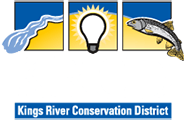The Kings River Fisheries Management Program (KRFMP) was launched in 1999 through cooperation between the Kings River Conservation District (KRCD), Kings River Water Association (KRWA), and the California Department of Fish and Wildlife (CDFW), to enhance the fisheries of the Kings River and Pine Flat Reservoir. Management goals were established for Pine Flat Reservoir and the 77 miles of river below Pine Flat. The past 25 years have been filled with hard work, effective partnerships, and physical improvements to the Kings River to ensure native fish and wildlife species have the habitat they need to thrive in a healthy river.
What a fish wants, what a fish needs:
Plenty of cool water – This is not a given in a climate prone to drought and extreme summer heat. It takes an ongoing commitment by humans to ensure there is enough flowing water in the Kings River and maintain temperature to support fish and their food sources. All 28 members of KRWA (p. 37-41) who hold water rights on the Kings River each devote 10% of their storage for this purpose. To further this effort, the Jeff L. Taylor Pine Flat Power Plant turbine bypass located at the base of Pine Flat Dam was completed in 2003. The dam was built with several outlet levels (bottom, middle, and top) that are used depending on reservoir elevation. The turbine bypasses allow water to pass through the dam via pipelines called ‘penstocks’ when power generation is not occurring, to blend water from the penstocks and other dam outlets to achieve the best possible downstream water temperature conditions for the fishery.
Habitat for eggs, fry, and adults – Fish need different things from their environment at different life stages. Eggs need to stay undisturbed until they mature and hatch into fry (young fish). Fry need shallow water, vegetation, and cobbled streambeds to provide cover from predators and slower water to keep from being swept downstream. Adult fish need cover from predators and access to food like aquatic and terrestrial insects, crayfish, and algae, and the right conditions for spawning.
To date, approximately 3,600 boulders have been placed in the Kings River between the U.S. Army Corps of Engineers’ (USACE) bridge just below Pine Flat Dam and Avocado Lake Park. The boulders create habitat structure for survival and rearing habitat for juvenile fish, low-flow habitat for adult fish, and refuge from high-velocity flows and feeding stations for both. Other structural enhancements of channel diversity include approximately 30 coves and jetties built along the riverbank between the USACE bridge and Fresno County’s Choinumni Park.
Reinforcements – Between 2012 and 2024, an astonishing 3,788,000 rainbow trout eggs were incubated by KRFMP staff and volunteers in the river-side incubator building just below Pine Flat Dam. Fry are released into the Kings River when they are about an inch long, and four-six weeks after hatching from eggs. In addition to the millions of trout fry raised and released into the river, nearly 210,000 farm-raised rainbow trout, 82,575 pounds, were purchased and released into the river to supplement the CDFW stocking program.
Checking in on native fish:
Each fall, KRFMP conducts its annual fish population survey to get an idea of how fish are faring. Surveys show that while population numbers fluctuate from year to year, native fish continue to be the dominant fish species found below Pine Flat Dam with a wide range of ages being recorded. This tells us instream conditions are suitable for maintaining naturally reproducing self-sustaining populations of native fish.
Funding and partnerships:
Most of the funding to support the fishery program each year is provided by KRWA, KRCD, and CDFW, and some comes from grants and donations. The nearly $6.4 million Jeff L. Taylor Pine Flat Power Plant turbine bypass project was designed and constructed by the USACE and cost-shared by KRCD, KRWA, CDFW, and California Department of Water Resources. Funding for rainbow trout eggs comes from the Kings River Conservancy through a grant provided by the Edward K. Martin Family Fund managed by the Central Valley Community Foundation. Locally, KRWA and KRCD commit to financially supporting the program. In-kind support is also provided by the agencies. Public access to the Kings River was made easier with construction of a gravel parking lot at Fresno County’s Greenbelt Park, on Piedra Road near Friant Canal in Sanger, funded in part by a grant from the Fresno County Recreation and Wildlife Commission and maintained by Fresno County Parks.
The incubator building, owned by Fresno County, was brought into operational shape with a $37,500 grant from the Edward K. Martin Family Fund. The 2,200-foot long Thorburn Spawning Channel was brought to fruition with a $116,000 grant from the California Transportation Commission’s Environmental Enhancement and Mitigation Program. The project serves to restore some of the riparian, wetland and woodland and elderberry habitat loss from construction of the Highway 180 realignment between Trimmer Springs Road and Frankwood Avenue by Caltrans. The project modified an existing side channel to create spawning and rearing habitat for trout, enhanced and preserved wetland, riparian, and oak habitats, and provided elderberry bushes to support elderberry longhorn beetles (a federally threatened species).
Many hands
Volunteers are an important and valued part of KRFMP’s ongoing success. People give their time and labor to do annual fish population surveys, daily care of trout eggs and fry at the incubator building, release fry into the river, and Kings River clean-ups every third Saturday of the month to collect trash and remove graffiti from recreation spots and trails along the Kings River. To date, volunteers have given over 5,100 hours of time. If you or your organization want to be part of this effort, visit www.krfmp.org/volunteer. We’re accepting volunteers right now for the fall fish population survey – November 21 and December 3, 4, 5. The next monthly cleanup is October 19.

